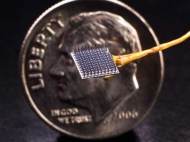Thought control of robotic arms using the BrainGate system
 Collaboration between researchers from Brown University, Massachusetts General Hospital (MGH), Providence VA Medical Center, as well as researchers from Stanford University who recently joined the project, resulted with the BrainGate project – a project where restorative neurotechnology is connected with externally powered communication systems, environmental control systems, and assistive devices by persons unable to use their hands due to physical impairment.
Collaboration between researchers from Brown University, Massachusetts General Hospital (MGH), Providence VA Medical Center, as well as researchers from Stanford University who recently joined the project, resulted with the BrainGate project – a project where restorative neurotechnology is connected with externally powered communication systems, environmental control systems, and assistive devices by persons unable to use their hands due to physical impairment.
While the results prove that it is possible to record brain signals that carry multi-dimensional information about movement even year after the trauma and exhibit the most complex functions to date that anyone has been able to perform using a BCI, they are still far from being practical for commercial use due to the fact that the presented results are preliminary, and the safety and effectiveness of the device have not been established.
The neural interface system consists of a baby aspirin-sized square of silicon sensor which contains 100 hair-thin electrodes used to monitor brain signals which are processed by computer software in order to control external devices. The sensor is implanted into the motor cortex, a part of the brain that directs movement. The implanted microelectrode array and associated neural recording hardware used in the BrainGate research are manufactured by BlackRock Microsystems LLC.
The BrainGate trial began in 2004 and was run by Cyberkinetics Inc., in collaboration with Brown University and MGH. After Cyberkinetics withdrew from the research for financial reasons, funding continued through this National Institute for Child Health and Human Development (NICHD) contract, MGH became the clinical trial and administrative lead, and the trial was renamed BrainGate2.
Two individuals paralyzed by stroke learned to use the BrainGate system to make reach-and-grasp movements with a robotic arm, as part of the BrainGate2 clinical trial. The trial participants used the BrainGate system under controlled conditions in their homes with a technician present to calibrate it. A 58-year-old woman and a 66-year-old man, both individuals are unable to speak or move their limbs because of brainstem strokes they had in 1996 and in 2006 (respectively). In the trial, both participants learned to perform complex tasks with a robotic arm by imagining the movements of their own arms and hands.
In one task, several foam targets were mounted on levers on a tabletop and programmed to pop up one at a time, at different positions and heights. The participants had less than 30 seconds to grasp each target using the DEKA Arm System (Generation 2), which is designed to work as a prosthetic limb for people with arm amputations. One participant was able to grasp the targets 62% of the time, and the other had a 46% success rate.
In some sessions, the woman controlled a DLR Light-Weight Robot III arm (we mentioned it in our article about humanoid robot Justin), which is heavier than the DEKA arm and designed to be used as an external assistive device. She used this arm prior to the DEKA arm in the foam target task, and had a 21% success rate. In other sessions with the DLR arm, she was able to complete four out of six attempts to reach for a bottled drink, bring it to her mouth and sip from a straw.
BrainGate research team envisions a system that would be faster, stable for decades, wireless and fully automated. Current version of the system uses a sensor which must be connected via cables to the rest of the system. Prior to each session with the robotic arms, a technician had to perform a calibration procedure that lasted 31 minutes on average, and a successful reach-and-grasp motion typically takes almost 10 seconds.
The ultimate goal for helping people with paralysis is to reconnect the brain directly to paralyzed limbs rather than robotic ones, the researchers said. In the future, the BrainGate system might be used to control a functional electrical stimulation (FES) device, which delivers electrical stimulation to paralyzed muscles (a technology that has shown promise in monkeys).
For more information, read the article published in the journal Nature: “Reach and grasp by people with tetraplegia using a neurally controlled robotic arm”.









author
The trial is currently recruiting and you can visit braingate2.org for more information.